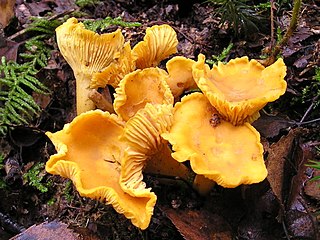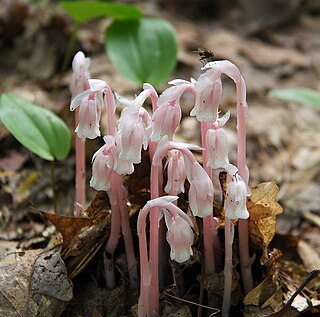
Mycology is the branch of biology concerned with the study of fungi, including their genetic and biochemical properties, their taxonomy and their use to humans as a source for tinder, medicine, food, and entheogens, as well as their dangers, such as toxicity or infection.

Basidiomycota is one of two large divisions that, together with the Ascomycota, constitute the subkingdom Dikarya within the kingdom Fungi.

The Russulales are an order of the Agaricomycetes,. According to the Dictionary of the Fungi, the order consists of 12 families, 80 genera, and 1767 species. According to Species Fungorum, the order contains 13 families, 117 genera, and 3,060 species.

A mycorrhiza is a symbiotic association between a fungus and a plant. The term mycorrhiza refers to the role of the fungus in the plant's rhizosphere, its root system. Mycorrhizae play important roles in plant nutrition, soil biology and soil chemistry.
In biological classification, a subfamily is an auxiliary (intermediate) taxonomic rank, next below family but more inclusive than genus. Standard nomenclature rules end subfamily botanical names with "-oideae", and zoological names with "-inae".

The Cantharellales are an order of fungi in the class Agaricomycetes. The order includes not only the chanterelles (Cantharellaceae), but also some of the tooth fungi (Hydnaceae), clavarioid fungi, and corticioid fungi (Botryobasidiaceae). Species within the order are variously ectomycorrhizal, saprotrophic, associated with orchids, or facultative plant pathogens. Those of economic importance include edible and commercially collected Cantharellus, Craterellus, and Hydnum species as well as crop pathogens in the genera Ceratobasidium and Thanatephorus (Rhizoctonia).

The fungal order Agaricales, also known as gilled mushrooms or euagarics, contains some of the most familiar types of mushrooms. The order has 33 extant families, 413 genera, and over 13000 described species, along with six extinct genera known only from the fossil record. They range from the ubiquitous common mushroom to the deadly destroying angel and the hallucinogenic fly agaric to the bioluminescent jack-o-lantern mushroom.

The opisthokonts are a broad group of eukaryotes, including both the animal and fungus kingdoms. The opisthokonts, previously called the "Fungi/Metazoa group", are generally recognized as a clade. Opisthokonts together with Apusomonadida and Breviata comprise the larger clade Obazoa.

The Eurotiales are an order of sac fungi, also known as the green and blue molds. The order contains three families, 49 genera, and 928 species. It was circumscribed in 1980.

The Trichocomaceae are a family of fungi in the order Eurotiales. Taxa are saprobes with aggressive colonization strategies, adaptable to extreme environmental conditions. Family members are cosmopolitan in distribution, ubiquitous in soil, and common associates of decaying plant and food material. The family contains some of the most familiar fungi, such as Penicillium and Aspergillus.
Narnaviridae is a family of positive single stranded RNA viruses. Members of this family have no capsid. Fungi serve as natural hosts. There are currently seven species in this family, divided among 2 genera.

A basidiospore is a reproductive spore produced by Basidiomycete fungi, a grouping that includes mushrooms, shelf fungi, rusts, and smuts. Basidiospores typically each contain one haploid nucleus that is the product of meiosis, and they are produced by specialized fungal cells called basidia. Typically, four basidiospores develop on appendages from each basidium, out of these 2 are of one strain and other 2 of its opposite strain. In gills under a cap of one common species, there exist millions of basidia. Some gilled mushrooms in the order Agaricales have the ability to release billions of spores. The puffball fungus Calvatia gigantea has been calculated to produce about five trillion basidiospores. Most basidiospores are forcibly discharged, and are thus considered ballistospores. These spores serve as the main air dispersal units for the fungi. The spores are released during periods of high humidity and generally have a night-time or pre-dawn peak concentration in the atmosphere.

Myco-heterotrophy is a symbiotic relationship between certain kinds of plants and fungi, in which the plant gets all or part of its food from parasitism upon fungi rather than from photosynthesis. A myco-heterotroph is the parasitic plant partner in this relationship. Myco-heterotrophy is considered a kind of cheating relationship and myco-heterotrophs are sometimes informally referred to as "mycorrhizal cheaters". This relationship is sometimes referred to as mycotrophy, though this term is also used for plants that engage in mutualistic mycorrhizal relationships.

Capnodiales is a diverse order of Dothideomycetes, initially based on the family Capnodiaceae, also known as sooty mold fungi. Sooty molds grow as epiphytes, forming masses of black cells on plant leaves and are often associated with the honeydew secreted by insects feeding on plant sap. This diverse order has been expanded by the addition of several families formerly thought unrelated and now also includes saprobes, endophytes, plant pathogens, lichens and rock-inhabiting fungi. The new additions include the genus Mycosphaerella containing the causal agents of several economically important crop and tree diseases. A small number of these fungi are also able to parasitise humans and animals, including species able to colonise human hair shafts.

In biological classification, taxonomic rank is the relative level of a group of organisms in a taxonomic hierarchy. Examples of taxonomic ranks are species, genus, family, order, class, phylum, kingdom, domain, etc.

Fungivory or mycophagy is the process of organisms consuming fungi. Many different organisms have been recorded to gain their energy from consuming fungi, including birds, mammals, insects, plants, amoebas, gastropods, nematodes, bacteria and other fungi. Some of these, which only eat fungi, are called fungivores whereas others eat fungi as only part of their diet, being omnivores.

A fungus is any member of the group of eukaryotic organisms that includes microorganisms such as yeasts and molds, as well as the more familiar mushrooms. These organisms are classified as a kingdom, fungi, which is separate from the other eukaryotic life kingdoms of plants and animals.

The corticioid fungi are a group of fungi in the Basidiomycota typically having effused, smooth basidiocarps that are formed on the undersides of dead tree trunks or branches. They are sometimes colloquially called crust fungi or patch fungi. Originally such fungi were referred to the genus Corticium and subsequently to the family Corticiaceae, but it is now known that all corticioid species are not necessarily closely related. The fact that they look similar is an example of convergent evolution. Since they are often studied as a group, it is convenient to retain the informal (non-taxonomic) name of "corticioid fungi" and this term is frequently used in research papers and other texts.
Megabirnaviridae is a family of viruses with one genus Megabirnavirus. Fungi serve as natural hosts. There is only one species in this family: the type species Rosellinia necatrix megabirnavirus 1. Diseases associated with this family include: reduced host virulence.
Quadriviridae is a family of viruses with a single genus Quadrivirus. Fungi serve as natural hosts. There is currently only one species in this family: the type species Rosellinia necatrix quadrivirus 1.

















